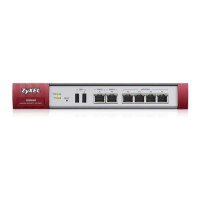Chapter 4 Status
ZyWALL Series CLI Reference Guide
52
4.2 CPU Temperature Monitor Commands
Use these commands to have the Zyxel Device periodically write CPU temperatures to the system logs.
4.3 System Protection Signature Commands
Use these commands to view the system protection signature information and update the signatures if
necessary.
Table 9 Dashboard Commands
COMMAND DESCRIPTION
show cpu-temperature-monitor
status
Displays whether CPU temperature monitoring is enabled, and
how often the temperature is written to the system logs.
[no] cpu-temperature-monitor
activate
Enables or disables CPU monitoring.
cpu-temperature-monitor period
minutes
Sets how often in minutes that the Zyxel Device writes CPU
temperature to the system logs. The valid range is 5-120.
cpu-temperature-monitor unit
{celsius| fahrenheit}
Sets the temperature unit that the Zyxel Device uses when it
writes CPU temperature to the system logs.
Table 10 System Protection Signature Commands
COMMAND DESCRIPTION
show system protection signatures
version
Displays system protection signatures of the Zyxel Device. These
signatures do not require a license.
The Zyxel Device will synch with the Cloud Helper Server every
day to update these signatures automatically. You can also
update manually using the command below.
Please note that in the web configurator, the system protection
signature version displays in Dashboard > About.
System protection signatures protect your Zyxel Device and local
networks from web attacks, such as command injection, cross-
site scripting and path traversal.
Command injection: This is an attack in which an attacker uses
the Zyxel Device vulnerabilities to execute commands to control
your Zyxel Device.
Cross-site scripting: This is an attack in which an attacker implants
malicious scripts in a website. When you visit this website, the
malicious scripts are sent and executed on your web browser.
Path traversal: This is an attack that allows an attacker to access
files you store in the web root folder.
show system protection signature
update status
Displays if the system protection signatures are updated to the
latest version.
system protection signature update
signature
Use this command to update the system protection signatures to
the latest version.
Make sure the Zyxel Device can access the Cloud Helper Server
when you want to update the signatures.

